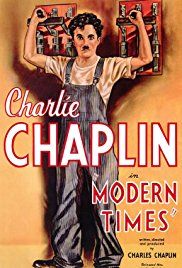MODERN TIMES
SUBJECTS — Cinema; U.S./1929 – 1941;
SOCIAL-EMOTIONAL LEARNING — Surviving;
MORAL-ETHICAL EMPHASIS — Trustworthiness; Caring.
AGE: 8+; No MPAA Rating;
Comedy; 87 minutes; 1936; B & W. Available from Amazon.com.
There is NO AI content on this website. All content on TeachWithMovies.org has been written by human beings.

SUBJECTS — Cinema; U.S./1929 – 1941;
SOCIAL-EMOTIONAL LEARNING — Surviving;
MORAL-ETHICAL EMPHASIS — Trustworthiness; Caring.
AGE: 8+; No MPAA Rating;
Comedy; 87 minutes; 1936; B & W. Available from Amazon.com.
This is a lighthearted satire of urban industrial life in the first half of the 20th century. While working on an assembly line, the “Little Tramp” gets a tick that makes him move like a machine. He then becomes stuck on a conveyor belt and run through another machine. He is used as a test dummy for a feeding machine. The boss spies on him in the men’s room through hidden cameras. He meets a waif and falls in love. He is mistakenly labeled a Communist and arrested. He encounters cocaine while in jail. He gets a job in a department store but loses it. He works as a waiter, only to lose that job. None of these setbacks crush his spirit.
“Modern Times” is acknowledged to be the last of the great silent movies. Although it does have some sound, there is no spoken dialogue.
Selected Awards: 1936 National Board of Review Awards: Ten Best Films of the Year. This film is listed in the National Film Registry of the U.S. Library of Congress as a “culturally, historically or aesthetically significant” film. This film is ranked #81 on the American Film Institute’s List of the 100 Greatest American Movies of All Time (2006). It is ranked #33 on the American Film Institute’s List of the 100 Funniest American Movies of All Time (2006).
Featured Actors: Charles Chaplin, Paulette Goddard, Henry Bergman, Stanley Sanford, Gloria DeHaven, Chester Conklin.
Director: Charles Chaplin.
While quite funny, “Modern Times” contains famous and enduring images that make serious social comments. It is also an excellent introduction to silent films, to Charlie Chaplin, one of the greatest actor/directors of all time, and to his classic “Little Tramp” character. The movie will also introduce children to the assembly line, the poverty of the Great Depression, the labor unrest that occurred during the Great Depression, and the redbaiting that was used to suppress labor unions. Note the scene in which the Little Tramp is spied on by the boss. The ability to spy on employees was science fiction in 1936 when the movie was made. It is reality today.
The first assembly line in the U.S. was built by Henry Ford in the 1913 at his plant in Highland Park. Basically, parts were placed on a conveyor belt and emplooyees worked on the parts as they passed by on the belt. The assembly line increased efficiency and reduced costs. Soon the assembly line spread throughout the manufacturing sector in countries throughout the world. As shown in the movie, work on an assembly line is repetitive and dehumanizing.
During the Great Depression, 1929 – 1939, the economy collapsed, many banks failed, and millions of people were thrown out of work. Full recovery occurred only as the U.S. geared up for war production just before World War II. The American labor movement first came into its own in the 1930s. There were strikes, marches, and demonstrations by workers as they sought better working conditions and wage increases. The police were often used to break up pro-union demonstrations and strikes. A few of the unions were led by Communists and this frightened many people. However, opponents of unions often charged that anyone associated with a union was a Communist just to discredit them. In the film, the Little Tramp is labeled as a Communist when he is accidentally caught up in the front of a labor union demonstration.
Charlie Chaplin was one of the world’s greatest comedians and movie makers. He also wrote much of the music for his films. His signature character was the Little Tramp. “Modern Times” was the last occasion in which the Little Tramp appeared and the last major feature-length silent film.
What do you think this film is trying to tell us about the effect of machines on our lives?
Suggested Response:
That we need to be careful that machines do not dominate our lives.
1. See Discussion Questions for Use With any Film that is a Work of Fiction.
2. Why is the Little Tramp such an endearing figure?
3. Why did the Little Tramp want to stay in jail a little longer?
4. Did the Little Tramp do the right thing by letting the Gamin into the department store?
5. Why was there no talking in the movie? How did it affect your ability to understand it?
6. Who was responsible for the death of the father?
Discussion Questions Relating to Ethical Issues will facilitate the use of this film to teach ethical principles and critical viewing. Additional questions are set out below.
(Be honest; Don’t deceive, cheat or steal; Be reliable — do what you say you’ll do; Have the courage to do the right thing; Build a good reputation; Be loyal — stand by your family, friends and country)
See Discussion Questions in the “Surviving” section above.
(Be kind; Be compassionate and show you care; Express gratitude; Forgive others; Help people in need)
1. How do the actions of the Little Tramp and the Gamin honor the Pillar of “Caring?”
“assembly line,” “Little Tramp,” union, Communist, Gamin.
Any other Chaplin film and The Grapes of Wrath. The first talkie was The Jazz Singer with Al Jolson.